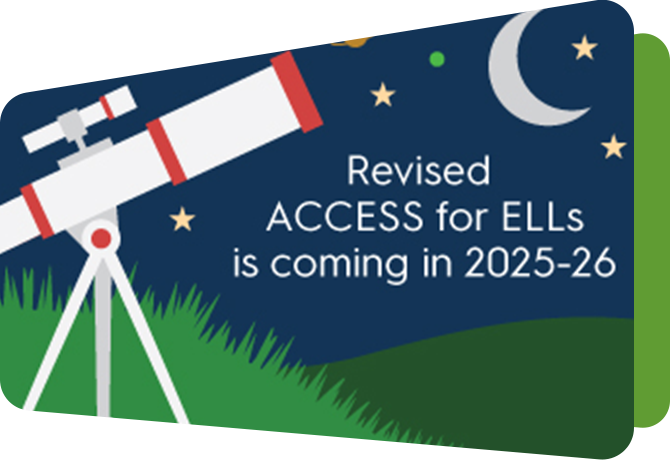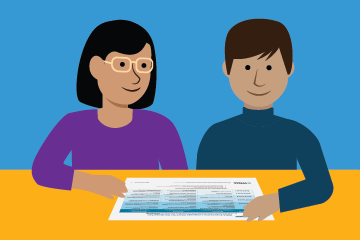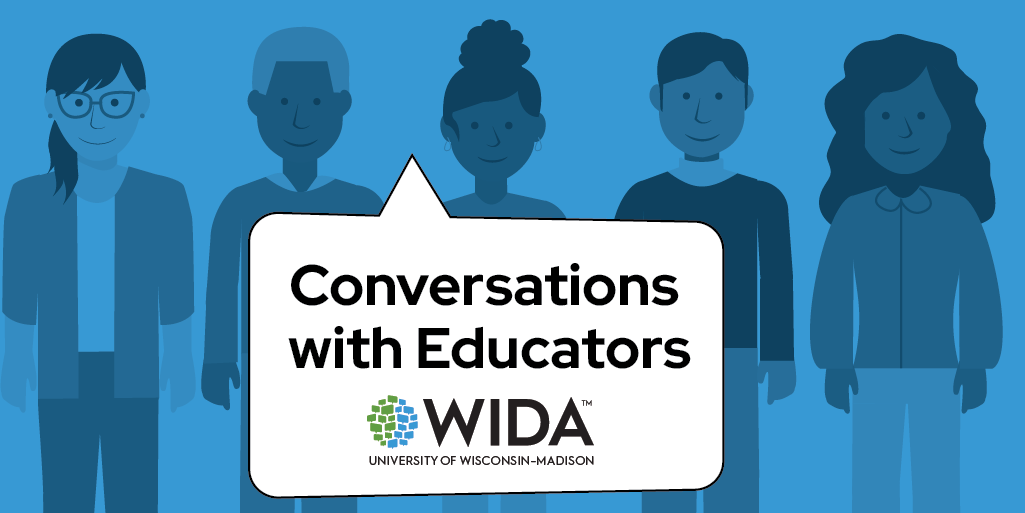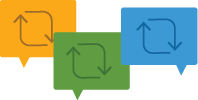October 2019 Featured Educator: Sheila Hickman
Please tell us about where you teach.
I’m an ESL teacher for Grades 9 – 12 at Neptune High School (NHS). I‘ve been teaching for 17 years and was hired in Neptune 11 years ago as the middle school and high school ESL teacher...the only one! Since I was hired, the ESL population has grown so much that I am now at the high school full time along with a second ESL teacher.
Describe your students and your teaching environment. What do language services look like in your school?
My ESL students range from beginners and newcomers, to students who have a high level of English proficiency. Neptune High School has approximately 1,300 students with approximately 80 ESL students. Our high school ESL population continues to grow every year. NHS has a block schedule, so we each teach three 80-minute blocks of ESL. We schedule blocks by language proficiency level.
The primary native languages of our ELLs are Spanish and Haitian Creole. However, we have a few Tagalog and Arabic-speaking students who have recently joined us as well. NHS is very diverse, with students from different parts of the world.
Besides our class instruction, we support content area teachers to help them best meet the needs of the ELLs in their classes. In the beginning of each semester, we share with our colleagues a list of our ELLs’ English language proficiencies in addition to the block and teacher they’re scheduled with.
In our classrooms, we also have materials (bilingual dictionaries, bilingual glossary sheets, and professional texts) that any of our colleagues can utilize. We also created a list of strategies the team can use when an ELL is referred. We also work alongside guidance to craft schedules for our ELLs to meet graduation requirements. I firmly believe that our team effort manifests itself in the success of our ELLs.
Why did you choose to become an educator? What do you love about your job? What frustrates you?
I didn’t start out as an educator. I was a business major in college. But while serving as a Peace Corps volunteer in the Dominican Republic, I realized that I wanted to pursue education. When I came back to the U.S., I was accepted into the New Jersey Alternate Route program (a program where non-education majors earn their teacher certification). I earned a Masters in Urban Education ESL as well. My desire to make a difference in the lives of children is what drove me to pursue my certifications. I always want to be the teacher who the students know cares.
There are so many things I love about my job. At the top of the list are the relationships I build with my students, which I maintain even after they’ve graduated. It has given me so much joy to attend Quinceaneras, sports events, graduations, bridal showers, weddings, and baby showers for my students and former students. I am so proud that my students know that I am always there for them. I love watching my students gain confidence as their English proficiency improves. I love bringing my students on field trips, and I love researching new places to bring them. I love creating a nurturing classroom environment for my students every year. When they walk through my classroom door that first day of school, I want them to know that I care. My classroom is evidence of that.
What frustrates me? Not having enough time! As high school ELLs, my students don’t have the luxury of time. They need to acquire a high level of English proficiency in addition to meeting all their high school graduation requirements. This is what drives me to give my students 100% every single day.
What is your approach towards supporting language learning in your classroom and school? What techniques/strategies have you found to be most effective in teaching language learners? Are certain WIDA tools helpful?
I make myself available to my students throughout the day. I’m an early bird, and I’ll have ELLs relaxing and chatting with each other before the school day even begins in a “serenity space.” Lunch is the same way. My students know that I enjoy their company and that the classroom is ours, not just mine. I create time and a safe space to help students build interpersonal skills. Students can speak in their native language or in English during this time, so it fosters bilingualism. It also allows them to see friends they may not interact with during the school day and brings them comfort and familiarity. I tell my students that they can come to me for questions and concerns not just for my class, but for their other classes as well. I advocate for my students and make sure they understand and are aware of programs and services that are available to them. I encourage my students to get involved in after-school activities and make sure I attend any school events that they are participating in.
I like giving my students opportunities to work independently, with a partner, in a small group and with the whole class. By giving my students these opportunities, I’m giving them time to develop not only their English proficiency, but their interpersonal skills too. The Gallery Walk is one activity that gives my ELLs the opportunity to do this. I print out and laminate pictures that tie in with the unit and post them in the hallway. During the Gallery Walk, my ELLs develop background knowledge and work on developing all four language skills—my ELLs are always partnered up during a Gallery Walk and with a student who does not speak the same native language, if possible. Those same pictures will be used again for another Gallery Walk at the end of the unit. During that Gallery Walk, my ELLs use their content vocabulary and knowledge acquired during instruction. It’s so gratifying for everyone to see the huge difference in their Gallery Walk sentences at the end of the unit.
I also like connecting activities to show my students that what we do isn’t done in isolation. I’ll use their sentences from their Gallery Walks in our “Messenger and Scribe” activity. (“Messenger and Scribe” is a game that develops both speaking and writing skills introduced by Joan Wink in her book, Critical Pedagogy: Notes from the Real World.) Messenger and Scribe is so much fun and can be adapted for any content area, grade level, and English language proficiency.
How do you encourage students to learn? How do you accelerate their language development and ensure their equitable access to content learning?
On the first day of school, my students write out their English language goal for the year. The goal is posted in our classroom, and we revisit it throughout the school year so my students can monitor their progress. I tell my students the goal must be specific, and they need to include their reason for that goal. This is a way I hold my students accountable for their English language learning. Seeing their goal posted reminds them about what they’ve done to achieve it and what they still need to do.
As a high school teacher, I make sure my students understand the importance of acquiring not only a high level of English proficiency but also in meeting high school graduation requirements. I am a firm believer in the importance of knowing why you’re doing something. We talk about their future goals and what they need to do in order to reach their goals. We also talk about the reason their families immigrated to the U.S. Without fail, all my students will answer that question with “to have a better life.” They understand that having a high level of English proficiency is a very important component of having a successful future in the U.S.
I want my students to take ownership of their learning, so we do a great deal of reflecting. By reflecting, my students recognize what they did well and what they still need to work on. At the bottom of every quiz or test my students take, they need to reflect on how they think they did. It can be something as simple as a smiley face or a sad face. Some students draw a neutral face. Others write a sentence. Their reflections give me valuable insight on how my ELLS are perceiving their own academic performance. It also gives my students the opportunity to recognize what they need to do, or continue doing, in order to improve their language skills.
I give my students many opportunities to be successful in my classroom and I provide a very structured environment that fosters their success. I write the day’s agenda for each block on the white board and refer to it during the course of the lesson. The students always have a “Do Now” (10-minute choice activity of writing or reading) and then we’ll either have a dictation or listening assessment. I incorporate video snippets frequently. I find songs that tie in with a topic or a book and have the students make text connections to it. They work independently on a writing task, but may sit in a group, which allows them to ask each other questions.
Everything on the walls has a purpose. We have a Word Wall for current content and a Power Word Wall that introduces new vocabulary each week. Students are tasked with using the power words or reporting if they hear others use them throughout their day. I utilize flexible seating options and have reading and writing nooks.
My ESL counterpart and I work with the department chair and guidance to also place eligible exited ELLs into honors and AP sections. We work with the teacher to focus on strengths and areas of focus and monitor student progress in the course.
Let’s talk about the WIDA English Language Development Standards. How do you determine which language standard(s) to focus on in a lesson? Describe your planning process to address the needs of your students. How do you manage to collaborate with content area teachers?
I take a lot of pride in the fact that I know my students very well. Prior to the end of the school year, my ESL colleague and I look at the results of ACCESS for ELLs. We use that information, in addition to our knowledge of the students, to place them by level in an ESL class for the following school year. We also work with our department chair to predict the needed growth on ACCESS for ESSA for each student. This enables us to start planning lessons according to areas of strengths and focus. We also plan a professional development workshop for the first day of school to introduce activities that staff can do in their content classes to strengthen target areas. We work together to build an individualized schedule for each ELL.
The students are placed in a class according to their language ability, which helps me target the lesson to meet their language needs. My students understand that the language skills are all connected and that developing their speaking skills, for example, will improve their writing skills. That is why listening, speaking, reading, and writing are incorporated into each lesson. The emphasis may be different, but all their language skills are utilized each class.
Sometimes, my students may be too shy to talk with a content area teacher about a question or problem they’re experiencing. In those situations, the student and I meet with the teacher and formulate a plan together. I am very fortunate that I have such wonderful colleagues who are very receptive to my ideas and suggestions. Without a doubt, we are a team!
What benefits of strength do language learners bring to your classroom and school? What benefits do their families bring to schools or the surrounding community?
The life experiences of my students enhance our ESL classroom and the school in so many ways. I love that my students are interacting with people from very different backgrounds from their own and are developing strong interpersonal skills in the process. It warms my heart when I see the relationships develop in my classroom between students from different countries. I want them to realize that these relationships are evidence of their ability to communicate with others using their English skills.
My ELLs participate in the department door decorating activity (my department chairman’s door) by decorating the door for December (holiday celebrations in their native countries) and May (Haitian Flag Day). They do a beautiful job with both doors, and it’s a terrific way for them to share aspects of their native countries with the rest of the student body. My ELLs also visit the Neptune Senior Center to share stories from their native countries with the seniors, who share back with them. I am so proud watching this interaction between not only generations, but cultures. My ELLs participate in Read Across America by visiting one of the Neptune elementary schools and reading with various grade levels. I couldn’t be prouder as I watch my students patiently explain the pictures and stories and answer the questions from students.
Just as I love my students, I really adore their parents and guardians. I know I can contact any of them with any concerns or questions I have about their children, and that they can contact me, too. I let my parents know that I appreciate all they do at home with their children and that their effort, along with mine, will help increase the success of their child. I feel it’s very important to establish a supportive, respectful relationship with the parents and every year I do.
Every year we have four ESL Parent Nights. These organized events, each with a different focus, give the parents of our ELLs the chance to meet with leaders of the community and with representatives from numerous community organizations. Last year, one of our events was a College and Career Night, where the parents were able to discuss financial aid concerns, high school requirements, and trade careers. The focus of one of our other family nights was ACCESS for ELLs. Not only did we explain the purpose of the test and how it would be administered, but we gave our parents the chance to actually complete the practice test. These events definitely strengthen the home-school connection.
What methods or tools do you use to assess your students' language learning?
ACCESS for ELLs gives me a lot of data about my students’ language development, and I use the data along with my personal knowledge of my students’ language development to gauge their strengths and weaknesses.
My students know that I am constantly assessing their language skills, whether via formative or summative assessments. My students know they are to be on task, and, as I say very often, “filling the unforgiving minute” from the moment they step into our classroom. They’ll work on their ESL Dialogue Journal (a great tool for not only assessing their writing, but to gain insight into their lives) or on their independent silent reading. During either of those initial activities, I’m assessing the oral reading fluency skills of another student one-to-one. We sit together and the student reads aloud from their oral reading fluency packet. Besides assessing their fluency and pronunciation, it gives me additional one-on-one time with my student.
As my colleague in charge of classroom supplies knows, I am a huge fan of Post-it Notes! We use them all the time in my class. One way we use them is during independent and partner reading. My students know that the current book we’re reading must be full of Post-it Notes. They use them to write their text connections and questions, to make observations on what they see in the photographs, and to make inferences. All English language proficiencies can participate in this formative assessment, because they can write words, phrases, or sentences. The Post-it Notes filling their book give my students a visual on how hard they’re working in class and it does fill them with a sense of pride.
Last year, I started the three-step edit, which has been invaluable in assessing my students’ writing. I’ll admit, I am a fan of the red pen, but my students are the ones using it! They use the red pen to do the initial edit of their writing. After they edit it, they ask a classmate to edit it also. This student uses a color pencil to edit (this distinguishes who did which edit) and writes their name at the top of the paper (this holds them accountable). The final edit is mine. During my edit, I sit with the student and go over the previous edits first, before I add any additional ones. Prior to the whole editing process, we brainstorm as a class about what to look for when you’re editing.
How has WIDA helped you achieve your goals as an educator?
Every day that I enter my classroom, I give 100% to my students. WIDA has helped me do that with the abundance of resources they provide. From the invaluable data from ACCESS for ELLs, to the webinars, to the CAN DO Descriptors, WIDA has given me the tools I need to meet the needs of my students.





